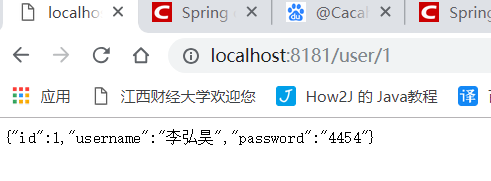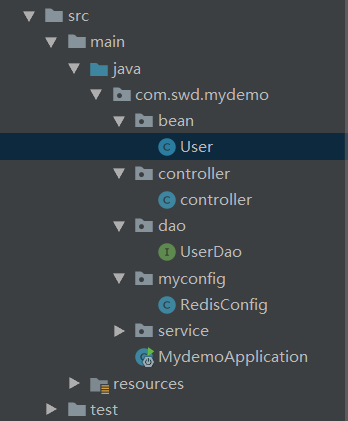记在前面:
@Cacheable@CachePut存入缓存里面的数据是方法执行的返回值
所以加了@CachePut的类的返回值要和加了@Cacheable的类的返回值一样
我的环境:
springboot2.x,idea
目录结构

mysql里面的表结构
CREATE TABLE `user` ( `id` int(30) NOT NULL AUTO_INCREMENT, `username` varchar(30) DEFAULT NULL, `password` varchar(30) DEFAULT NULL, PRIMARY KEY (`id`) )

配置文件application.properties

server.port=8181 spring.datasource.type=com.alibaba.druid.pool.DruidDataSource spring.datasource.url=jdbc:mysql://127.0.0.1:3306/cache?useUnicode=true&characterEncoding=UTF-8&serverTimezone=UTC spring.datasource.username=root spring.datasource.password=123456
pom.xml

<?xml version="1.0" encoding="UTF-8"?> <project xmlns="http://maven.apache.org/POM/4.0.0" xmlns:xsi="http://www.w3.org/2001/XMLSchema-instance" xsi:schemaLocation="http://maven.apache.org/POM/4.0.0 https://maven.apache.org/xsd/maven-4.0.0.xsd"> <modelVersion>4.0.0</modelVersion> <parent> <groupId>org.springframework.boot</groupId> <artifactId>spring-boot-starter-parent</artifactId> <version>2.2.2.RELEASE</version> <relativePath/> <!-- lookup parent from repository --> </parent> <groupId>com.swd</groupId> <artifactId>mydemo</artifactId> <version>0.0.1-SNAPSHOT</version> <name>mydemo</name> <description>Demo project for Spring Boot</description> <properties> <java.version>1.8</java.version> </properties> <dependencies> <dependency> <groupId>org.springframework.boot</groupId> <artifactId>spring-boot-starter-web</artifactId> </dependency> <dependency> <groupId>org.mybatis.spring.boot</groupId> <artifactId>mybatis-spring-boot-starter</artifactId> <version>2.1.1</version> </dependency> <dependency> <groupId>mysql</groupId> <artifactId>mysql-connector-java</artifactId> <scope>runtime</scope> </dependency> <dependency> <groupId>org.projectlombok</groupId> <artifactId>lombok</artifactId> <optional>true</optional> </dependency> <dependency> <groupId>org.springframework.boot</groupId> <artifactId>spring-boot-starter-test</artifactId> <scope>test</scope> <exclusions> <exclusion> <groupId>org.junit.vintage</groupId> <artifactId>junit-vintage-engine</artifactId> </exclusion> </exclusions> </dependency> <dependency> <groupId>com.alibaba</groupId> <artifactId>druid</artifactId> <version>1.1.10</version> </dependency> </dependencies> <build> <plugins> <plugin> <groupId>org.springframework.boot</groupId> <artifactId>spring-boot-maven-plugin</artifactId> </plugin> </plugins> </build> </project>
启动类

package com.swd.mydemo; import org.apache.ibatis.annotations.Mapper; import org.mybatis.spring.annotation.MapperScan; import org.springframework.boot.SpringApplication; import org.springframework.boot.autoconfigure.SpringBootApplication; import org.springframework.cache.annotation.EnableCaching; @SpringBootApplication @EnableCaching @MapperScan("com.swd.mydemo.dao") public class MydemoApplication { public static void main(String[] args) { SpringApplication.run(MydemoApplication.class, args); } }
controller层
package com.swd.mydemo.controller; import com.swd.mydemo.bean.User; import com.swd.mydemo.service.UserService; import org.springframework.beans.factory.annotation.Autowired; import org.springframework.web.bind.annotation.GetMapping; import org.springframework.web.bind.annotation.PathVariable; import org.springframework.web.bind.annotation.RestController; /** * @program: mydemo * @Date: 2019/12/25 14:36 * @Author: lhh * @Description: */ @RestController public class controller { @Autowired UserService userService; @GetMapping("user/{id}") public User getUserById(@PathVariable("id") Integer id) { return userService.getUserById(id); } @GetMapping("user") public void updateUserById(User user) { userService.updateUserById(user); } }
bean层
package com.swd.mydemo.bean; import lombok.Data; /** * @program: mydemo * @Date: 2019/12/25 14:30 * @Author: lhh * @Description: */ @Data public class User { private int id; private String username; private String password; }
dao层
import com.swd.mydemo.bean.User; import org.apache.ibatis.annotations.Mapper; import org.apache.ibatis.annotations.Select; import org.apache.ibatis.annotations.Update; /** * @program: mydemo * @Date: 2019/12/25 14:32 * @Author: lhh * @Description: */ @Mapper public interface UserDao { @Select("select * from user where id = #{id}") User getById(Integer id); @Update("update user set username = #{username} , password = #{password} where id = #{id}") void updateById(User user); }
service层
package com.swd.mydemo.service; import com.swd.mydemo.bean.User; import com.swd.mydemo.dao.UserDao; import org.springframework.beans.factory.annotation.Autowired; import org.springframework.cache.annotation.CachePut; import org.springframework.cache.annotation.Cacheable; import org.springframework.stereotype.Service; /** * @program: mydemo * @Date: 2019/12/25 14:34 * @Author: lhh * @Description: */ @Service public class UserService { @Autowired UserDao userDao; @Cacheable(cacheNames = "userw",key = "#id")//key里面的id取得是参数id(url传过来的是1) public User getUserById(Integer id) { System.out.println("查询"+id+"员工"); User user = userDao.getById(id); return user; } @CachePut(cacheNames = "userw",key = "#result.id")//result.id和user.id都可以(user.id是1) public User updateUserById(User user) { System.out.println("更新"+user.getId()+"员工"+user.getUsername()); userDao.updateById(user); return user; } }
在chrome中测试

在chrome多点几次回车查询,在idea控制台里面,public User getUserById(Integer id)这个方法只执行了一次,其他都是从缓存里面取的结果到chrome界面里

更新

页面没报错,控制台显示更新成功

结果:
数据库表里面更新成功

缓存更新成功,页面取的数据是从已经更新了的缓存里面取出来的

在来看idea控制台,可见从数据库里面查数据只查询了一次,其他都是从缓存里面查询出来的,牛皮!!

如果方便请点个赞呀,兄弟们。想要源码的可以留言评论哦。
记在后面:
@Cacheable标注的方法执行之前先来检查缓存中有没有这个数据,默认按照参数的值作为key去查询缓存,
如果没有就运行方法并将结果放入缓存;以后再来调用就可以直接使用缓存中的数据;
@CachePut:既调用方法,又更新缓存数据;
修改了数据库的某个数据,同时更新缓存;
@CacheEvict:缓存清除
key:指定要清除的数据
allEntries = true:指定清除这个缓存中所有的数据
二、上面已经完成了cache缓存,下面我们来整合redis
目录结构,新加了myconfig

在pom文件里面加上
<dependency>
<groupId>org.springframework.boot</groupId>
<artifactId>spring-boot-starter-data-redis</artifactId>
</dependency>
新建一个config路径,在此路径下面新建一个RedisConfig,这里的配置,可以让cache的缓存直接存在redis里面,key和value也已经序列化了,存在redis里面的也是json格式的,还有一个点就是你的实体类要
implements Serializable
import com.fasterxml.jackson.annotation.JsonAutoDetect; import com.fasterxml.jackson.annotation.PropertyAccessor; import com.fasterxml.jackson.databind.ObjectMapper; import org.springframework.cache.annotation.CachingConfigurerSupport; import org.springframework.cache.annotation.EnableCaching; import org.springframework.context.annotation.Bean; import org.springframework.context.annotation.Configuration; import org.springframework.data.redis.cache.RedisCacheConfiguration; import org.springframework.data.redis.cache.RedisCacheManager; import org.springframework.data.redis.connection.RedisConnectionFactory; import org.springframework.data.redis.core.RedisTemplate; import org.springframework.data.redis.serializer.Jackson2JsonRedisSerializer; import org.springframework.data.redis.serializer.RedisSerializationContext; import org.springframework.data.redis.serializer.RedisSerializer; import org.springframework.data.redis.serializer.StringRedisSerializer; import java.text.SimpleDateFormat; import java.time.Duration; /** * @program: mydemo * @Date: 2019/12/26 16:48 * @Author: lhh * @Description: */ @Configuration @EnableCaching public class RedisConfig extends CachingConfigurerSupport { @Bean public RedisTemplate<String,Object> redisTemplate(RedisConnectionFactory redisConnectionFactory){ /** * 配置自己的redisTemplate * StringRedisTemplate 默认使用使用StringRedisSerializer来序列化 * RedisTemplate 默认使用JdkSerializationRedisSerializer来序列化 */ RedisTemplate<String, Object> redisTemplate = new RedisTemplate<>(); redisTemplate.setConnectionFactory(redisConnectionFactory); //开启默认类型 ObjectMapper objectMapper = new ObjectMapper(); objectMapper.setVisibility(PropertyAccessor.ALL, JsonAutoDetect.Visibility.ANY); objectMapper.enableDefaultTyping(ObjectMapper.DefaultTyping.NON_FINAL); objectMapper.setDateFormat(new SimpleDateFormat("yyyy/MM/dd HH:mm:ss")); // 使用Jackson2JsonRedisSerialize替换默认序列化 Jackson2JsonRedisSerializer jackson2JsonRedisSerializer = new Jackson2JsonRedisSerializer(Object.class); jackson2JsonRedisSerializer.setObjectMapper(objectMapper); //设置key和value的序列化规则 redisTemplate.setKeySerializer(new StringRedisSerializer()); redisTemplate.setValueSerializer(jackson2JsonRedisSerializer); redisTemplate.setHashKeySerializer(new StringRedisSerializer()); redisTemplate.setHashValueSerializer(jackson2JsonRedisSerializer); redisTemplate.afterPropertiesSet(); return redisTemplate; } @Bean public RedisCacheManager cacheManager(RedisConnectionFactory factory) { RedisSerializer<String> redisSerializer = new StringRedisSerializer(); Jackson2JsonRedisSerializer jackson2JsonRedisSerializer = new Jackson2JsonRedisSerializer(Object.class); //解决查询缓存转换异常的问题 ObjectMapper om = new ObjectMapper(); om.setVisibility(PropertyAccessor.ALL, JsonAutoDetect.Visibility.ANY); om.enableDefaultTyping(ObjectMapper.DefaultTyping.NON_FINAL); jackson2JsonRedisSerializer.setObjectMapper(om); //配置序列化(解决乱码的问题) RedisCacheConfiguration config = RedisCacheConfiguration.defaultCacheConfig() .entryTtl(Duration.ZERO) .serializeKeysWith(RedisSerializationContext.SerializationPair.fromSerializer(redisSerializer)) .serializeValuesWith(RedisSerializationContext.SerializationPair.fromSerializer(jackson2JsonRedisSerializer)) .disableCachingNullValues(); RedisCacheManager cacheManager = RedisCacheManager.builder(factory) .cacheDefaults(config) .build(); return cacheManager; } }
